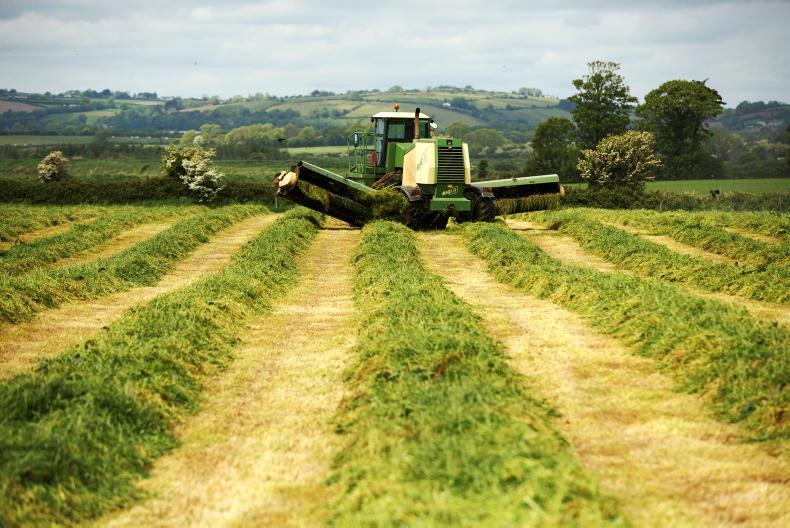The optimum wilting period will depend on a number of factors. Ideally we want to be picking silage up at 25% to 30% dry matter.
Below this and we are leaving the crop more open to losses and spoilage, not to mention the fact that more zero-feed-value water is going into our clamp or bale stack. However, dry matters that are too high (>35%) can lead to reduced intakes and reduced aerobic stability at feedout.
Table 1 outlines the optimum wilting periods for crops based on swatch management and dry matter targets.

It has been long said that May silage should be the aim where quality is sought after.
Those targeting a late-May cut have been largely granted their wish thus far, with ideal conditions countrywide in recent days.
From here on in, grass digestibility (feed value) will be decreasing weekly, albeit as yield increases. Table 2 outlines how delayed first-cut silage date affects quality, yield and animal performance.

While quality is important, yield must come into the equation too, both from production cost and feed supply points of view.
Ask yourself what you need to feed. Those feeding weanlings or finishing cattle need to be aiming for 75% DMD material. Silage for autumn-calved cows should be no lower than 70% DMD – ideally the higher the better. Aim for similar quality for feeding dry dairy cows.
Spring-calving sucklers, in optimum body condition score, will get by on 65% DMD material. In feed budgeting terms, dry and calved sucklers will consume nine and 12kg of silage DM daily.
Dry dairy cows will consume 12kg DM daily.
Weanlings and finishing cattle will require 6kg and 9kg DM.
Use table 3 as a guide to relative costs of silage based on yield and tables 2 and 3 to project yields and costs based on cutting dates.

Read more
Full coverage of everything that's happening from silage 2017
In pictures: silage season in full swing
Driver shortage hits silage season
The optimum wilting period will depend on a number of factors. Ideally we want to be picking silage up at 25% to 30% dry matter.
Below this and we are leaving the crop more open to losses and spoilage, not to mention the fact that more zero-feed-value water is going into our clamp or bale stack. However, dry matters that are too high (>35%) can lead to reduced intakes and reduced aerobic stability at feedout.
Table 1 outlines the optimum wilting periods for crops based on swatch management and dry matter targets.

It has been long said that May silage should be the aim where quality is sought after.
Those targeting a late-May cut have been largely granted their wish thus far, with ideal conditions countrywide in recent days.
From here on in, grass digestibility (feed value) will be decreasing weekly, albeit as yield increases. Table 2 outlines how delayed first-cut silage date affects quality, yield and animal performance.

While quality is important, yield must come into the equation too, both from production cost and feed supply points of view.
Ask yourself what you need to feed. Those feeding weanlings or finishing cattle need to be aiming for 75% DMD material. Silage for autumn-calved cows should be no lower than 70% DMD – ideally the higher the better. Aim for similar quality for feeding dry dairy cows.
Spring-calving sucklers, in optimum body condition score, will get by on 65% DMD material. In feed budgeting terms, dry and calved sucklers will consume nine and 12kg of silage DM daily.
Dry dairy cows will consume 12kg DM daily.
Weanlings and finishing cattle will require 6kg and 9kg DM.
Use table 3 as a guide to relative costs of silage based on yield and tables 2 and 3 to project yields and costs based on cutting dates.

Read more
Full coverage of everything that's happening from silage 2017
In pictures: silage season in full swing
Driver shortage hits silage season









 This is a subscriber-only article
This is a subscriber-only article










SHARING OPTIONS: